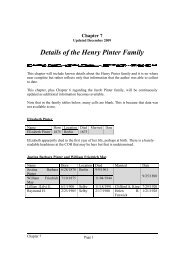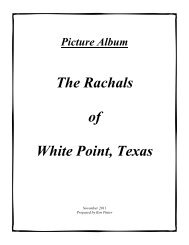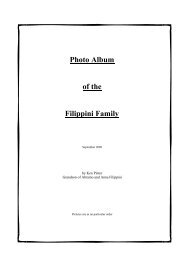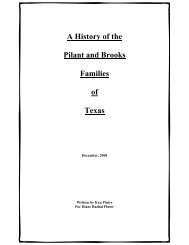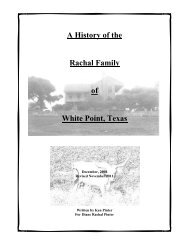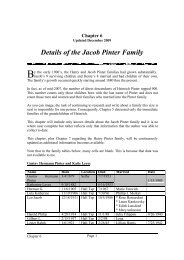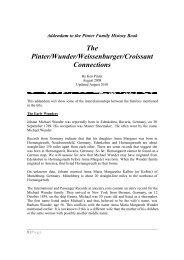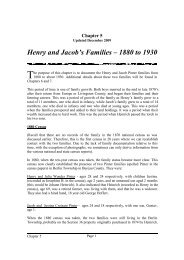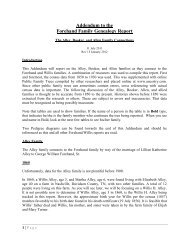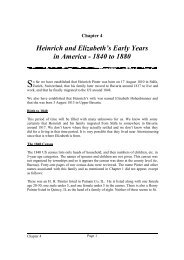The Gustav Herman Pinter Family - New Page 1
The Gustav Herman Pinter Family - New Page 1
The Gustav Herman Pinter Family - New Page 1
You also want an ePaper? Increase the reach of your titles
YUMPU automatically turns print PDFs into web optimized ePapers that Google loves.
Addendum to the <strong>Pinter</strong> <strong>Family</strong> History Book<br />
<strong>The</strong> <strong>Gustav</strong> <strong>Herman</strong> <strong>Pinter</strong> <strong>Family</strong><br />
By Ken <strong>Pinter</strong><br />
Grandson of <strong>Gustav</strong> <strong>Herman</strong> <strong>Pinter</strong><br />
June 2008<br />
Rev: July 2013<br />
Introduction<br />
<strong>Gustav</strong> <strong>Herman</strong> <strong>Pinter</strong> was born 4 March 1879 in an unidentified township in Bureau<br />
County, Illinois. He was the first child born to Jacob and Justina Croisant <strong>Pinter</strong>.<br />
<strong>The</strong> exact location of his birth is not clear but it may have been on his grandfather<br />
Heinrich <strong>Pinter</strong>’s farm in Section 36 of Berlin Tsp. This speculation is based on the<br />
following timeline for the <strong>Pinter</strong> family:<br />
1) First, recall that the whereabouts of Heinrich and his sons cannot be verified<br />
between 1866 and 1874.<br />
2) Henry Jr. married Julianna Wunder on 4 January 1874 in Bureau County. It is<br />
thought that Henry and Julianna lived with Heinrich and Jacob in Livingston<br />
County for some months after their marriage.<br />
3) Heinrich sold his property in Livingston and on 15 October 1874 he purchased an<br />
80 acre farm in section 36 of Berlin Township.<br />
4) <strong>The</strong> 1877 Voters and Taxpayers of Berlin Township document indicated that both<br />
Henry and Jacob “lives with father”. This would suggest that in 1877, Heinrich<br />
and Jacob plus Henry and his wife all lived together in Section 36 of Berlin<br />
Township.<br />
5) Jacob and Justina married on 28 October 1878. <strong>The</strong>y may well have stayed on this<br />
farm until they were able to purchase or rent property of their own. .<br />
6) Gus was born 4 March 1879.<br />
7) In 1880, the census showed that Henry and Julia were living near to Jacob and<br />
Justina while Heinrich is living with Henry. <strong>The</strong> census data shows there were<br />
two different families and two different dwellings, but near to each other (next to<br />
each other on the census page). This suggests that either two farmhouses existed<br />
on the property in Section 36, or else, one of the families, quite possibly Jacob,<br />
was renting a nearby farm.<br />
8) Heinrich deeded the land in Section 36 to his oldest son Henry in 1882 but<br />
Heinrich and Henry and family continued to live on the farm.<br />
1 | P a g e
9) Jacob purchased land in section 30 of Westfield Township in 1882 from his father<br />
in law and probably moved his family of 5 there soon after the purchase. It is<br />
thought that a farmhouse existed on the very north end of the property but that<br />
eventually Jacob built a farm somewhat more south. This is where Gus lived until<br />
he married Katie Leyes in 1905.<br />
All of the above suggests but does not prove that when Gus was born in 1879, his<br />
parents Jacob and Justina were living in Section 36 of Berlin Township, most<br />
likely near his brother Henry and father Heinrich, and that they moved to<br />
Westfield Township in 1882 when Gus was about 3 years old.<br />
<strong>The</strong>re is no other evidence now to prove or disprove the above assumptions.<br />
Gus was baptized on 22 June 1879 at the St. John’s Evangelical Lutheran Church. <strong>The</strong><br />
name on the certificate was <strong>Herman</strong>n <strong>Gustav</strong> <strong>Pinter</strong>. <strong>The</strong> Germans often reversed the first<br />
and middle names. His certificate of baptism states that his father Jacob was from (born<br />
in) Selby Township while his mother Justina was from (born in) Hollowayville in Selby<br />
Township. <strong>The</strong>re is no known certificate of birth for Gus.<br />
<strong>The</strong> picture at right is Gus. <strong>The</strong> exact date unknown but it was probably<br />
taken some time in 1883-85, that is, age 4 to 6.<br />
<strong>Gustav</strong> <strong>Herman</strong> <strong>Pinter</strong> (name as it appears on the confirmation<br />
certificate) was confirmed on 26 March 1893 at the St. John’s<br />
Evangelical Lutheran Church near Hollowayville (<strong>The</strong> Church on the<br />
Hill). His confirmation certificate and group photo of the confirmation<br />
class confirms that his birth date is 4 March 1879.<br />
<strong>Gustav</strong> married Katharine (Katie) Leyes on 15 January<br />
1905 in Selby Township (Church on the Hill) at the age of<br />
25. Katie was about 23 years old. <strong>The</strong> marriage certificate<br />
states that Gus was from Westfield Township while Katie<br />
was from Hall Township. <strong>The</strong> picture at the right shows<br />
Gus and Katie, seated. Attendants were Fred and Justina<br />
(Gus’ sister) Hassler<br />
Katharine Leyes was born in Illinois 18 September 1882, in<br />
Hall Township, Bureau County, probably Ladd. She was<br />
baptized 14 December 1882 with the name Katharine Leyes.<br />
<strong>The</strong> name Leyes is pronounced “Lee’s”.<br />
2 | P a g e
Chronology of the Gus <strong>Pinter</strong> <strong>Family</strong><br />
<strong>The</strong> following paragraphs detail significant times in the life of the Gus <strong>Pinter</strong> family in<br />
chronological order.<br />
1905<br />
Gus lived with his parents and brothers and sisters in Westfield Township, section 30,<br />
until his marriage to Katie in 1905. <strong>The</strong>re is currently no data available that identifies<br />
where Gus and Katie lived immediately after their wedding. One possibility is that they<br />
lived with his parents for a while. In this case the residence would have been Jacob’s<br />
farm in Westfield section 30, but this was a small house and the family was large.<br />
Another possibility is that they lived with her parents. <strong>The</strong>re is some precedence for<br />
living with a parent in this time. Or, maybe they rented a house or farm in the area.<br />
Unfortunately, rentals are typically not documented anywhere and often impossible to<br />
track. Rentals or leases were usually consummated with a handshake or simple written<br />
agreement in that time.<br />
1910 census<br />
3 | P a g e<br />
<strong>The</strong>re is a postcard written by Gus to his wife Katie in<br />
August of 1909. <strong>The</strong> card was postmarked in Sioux Falls,<br />
SD. He wrote that they had “65 miles to yet go to get to<br />
harvest”. This suggests that Gus and perhaps others<br />
travelled to South Dakota to help with a harvest. Perhaps<br />
the harvest was to be on his dad Jacob’s farm in South<br />
Dakota, or maybe Gus and others went there looking for<br />
harvest work.<br />
<strong>The</strong> following table shows the Gus <strong>Pinter</strong> family in 1910 per the US census:<br />
Name Age at census Actual Birth<br />
Date<br />
Gus <strong>Pinter</strong> 31 3/4/1879<br />
Katie 27 9/18/1882<br />
<strong>Herman</strong> 4 11/6/1905<br />
Lula 3 11/29/1906<br />
In 1910, the census recorded that Gus was renting a farm that was located in Hall<br />
Township, Bureau County. <strong>The</strong>y had two boarders (farm hands). According to the census<br />
data, Gus’ occupation was listed as farmer.<br />
It is not possible to tell from the census data where the farm<br />
was exactly located. It was in Hall Township, but not in<br />
Ladd. This information can be found in the 1910 census,<br />
Bureau Co, Hall Township, Enumeration District #11. ED
#11 includes part of but not all of Hall Township. <strong>The</strong><br />
specific sections of the township are not provided in the<br />
census.<br />
An attempt was made to locate the general area where the<br />
farm was in Hall Township. This was done by comparing<br />
plat maps for Hall Township in 1905 and 1916 to the 1910<br />
census (there were no plat maps drawn between 1905 and<br />
1916). <strong>The</strong> maps show the owners of land in the township<br />
in those years. <strong>The</strong> census shows the names of the actual<br />
families who lived on the farms. <strong>The</strong> order to their<br />
occurrence on the census sheets corresponds to the route<br />
the census taker took and this should indicate the proximity<br />
of one resident to the other.<br />
Farmers who lived nearby to Gus (according to the census)<br />
and who owned their farms (and thus would appear on the<br />
maps) were found in sections 11, 13, and 14 in Hall<br />
Township. All are to the east of Ladd. It is possible to also<br />
include section 10 and maybe 12 and with a little stretch,<br />
section 9 (the farm he bought in 1912 was in section 9).<br />
Unfortunately, with the data available, this is the best we<br />
can do in terms of identifying Gus’ farm location between<br />
1905 and 1916, in general, and 1910 in particular.<br />
.<br />
Gus Acquires the Farm in Section 9 Hall Township North of Ladd<br />
On 19 January 1912, according to the Bureau Co Grantee Index and a legal affidavit<br />
found in the Bureau County Courthouse, Gus purchased the farmland on the north side of<br />
Ladd from Henry and Sophia Hoerner of Peru, IL. This was the east half of the NE<br />
quarter of Section 9 of Hall Township. It was 78.1 acres. Approximately 1.9 acres of this<br />
80 acre 1/8 th section were not included in the sale.<br />
Note: It is not unreasonable to think that Gus was renting this farm in the Northeast<br />
quarter of section 9 and that later he tried to buy it from the Hoerners. However, there is<br />
problem with this thought that will be evident below.<br />
An agreement was drawn up between Gus and the Hoerners. <strong>The</strong> purchase price was<br />
$10,200 (about $130 per acre) and it was agreed that Gus would make payments of $500<br />
per year between 1913 and 1921 and he would then pay a balloon payment in 1922. This<br />
agreement is on file in the Bureau County Courthouse. A very important caveat in this<br />
agreement was how the payments would be made and what would be the consequences of<br />
default. In essence, this sale involved seller financing and the Hoerners would be the<br />
4 | P a g e
mortgagers and would have the option to retake possession of the farm in the event of a<br />
default. <strong>The</strong> caveat would prove to be a problem for Gus in the future.<br />
It is not known if there was a residential dwelling but the agreement required Gus to<br />
provide insurance for all buildings on the land. We don’t know if Gus and family<br />
immediately moved there or if a house had to be built first. If a home was built, more<br />
than likely Gus built it.<br />
A 1916 map of Hall Township shows that Gus H. <strong>Pinter</strong> owned this property and that it<br />
was 78.76 acres. It is not clear where the additional fraction of an acre (0.66 acres) came<br />
from.<br />
It is important to note here that there is evidence that the residence of Gus and family was<br />
probably at another location but not on this farm site for a period of years after he bought<br />
this farm in 1912. This will become evident when we look at the 1920 census.<br />
An interesting sidelight: Ladd’s first public school was<br />
built on this land in 1864. At the time, the property was<br />
owned by Irwin Borger. <strong>The</strong> school was named the Borger<br />
School. Sometime before 1900, the school was moved to<br />
land south of Ladd. When it was on the Borger land, it was<br />
situated just a short distance south from the spot of the<br />
future Gus <strong>Pinter</strong> home.<br />
Sale of Katie’s Parents Farm<br />
In 1914, Katie (and Gus), her sister Lizzie Helm, and sister Barbara Hassler, and sister<br />
Pena (and Henry) Walch sold a property in section 20 of Hall township. This property<br />
belonged to Joseph and Anna Leyes (Katie’s parents) and was an inheritance. <strong>The</strong>y both<br />
died just months apart in 1912. <strong>The</strong> property was the E1/2 of the NW quarter of section<br />
20, Hall Township. This property today is located south of Route 6 and about half way<br />
between Seatonville and Route 89.<br />
One Other Land Transaction<br />
In 1916, Gus purchased a lot within the city limits of Ladd for $90. This lot was Lot 12<br />
Block 44. This lot was in town on the east side of Main Street and a block north of<br />
Cleveland St. where Selby and Locust streets intersect today. Cleveland St is the<br />
east/west street that defines the southern edge of Ladd. This lot was purchased from John<br />
Blee. It is thought that Gus never lived at this location. Perhaps the property was<br />
purchased as an investment or for retirement.<br />
5 | P a g e
Gus Registers for the Military Draft<br />
On September 12, 1918, Gus registered for the military draft. All U.S. males in a certain<br />
age range were required to register because of WWI. <strong>The</strong> war ended soon after he<br />
registered. From Gus’ registration, we find the following personal description<br />
information:<br />
<strong>Gustav</strong> <strong>Herman</strong> <strong>Pinter</strong><br />
Age 39, dob March 4, 1879<br />
Farmer<br />
Medium height, medium build<br />
Brown eyes, brown hair<br />
Nearest relative: Kate <strong>Pinter</strong><br />
Place of residence: Ladd, Bureau, IL<br />
1920 Census<br />
A 1916 township map for Hall Township shows that Gus was owner of the farm in<br />
Section 9.<br />
In 1920, the census data indicated that Gus and family were living on Cleveland Street in<br />
Hall Township. <strong>The</strong> recording on the census page indicated that Gus was a farmer and<br />
that he owned his farm and that he had a mortgage. <strong>The</strong> census shows that they had 5<br />
children and two boarders: Irwin Hassler and one other (Note: Irwin Hassler was the son<br />
of Barbara Leyes Hassler, Katie’s sister). Gus’ occupation was given as Manager,<br />
General Farming.<br />
This table shows the Gus <strong>Pinter</strong> family in 1920:<br />
Name Age at census Actual Birth<br />
Date<br />
Gus <strong>Pinter</strong> 40 3/4/1879<br />
Katie 37 9/18/1882<br />
<strong>Herman</strong> 14 11/6/1905<br />
Lula 13 11/29/1906<br />
Leo 8 12/28/1911<br />
Harold 5 4/28/1914<br />
Gilbert 2 ½ 2/15/1917<br />
This data is seemingly contradictory to the fact that Gus purchased the north Ladd farm<br />
in 1912.<br />
In addition, one other farmer was listed on Cleveland Street: Catherine Nellis. It is not<br />
clear if she was living in a residence or physically on a farm. <strong>The</strong> remaining<br />
6 | P a g e
approximately 13 residents on Cleveland Street were miners or railroad workers. In<br />
addition, they were all found in Enumeration District 11 which in 1920 was bounded on<br />
the south by Cleveland Street. To be in ED #11, one had to be living on the North side of<br />
Cleveland Street. In Ladd, these were all single family residences.<br />
<strong>The</strong> most likely explanation that fits this unlikely scenario is that the farm in section 9<br />
possibly had no farm house or one was being built or renovated. <strong>The</strong>refore, the family<br />
needed a home and so they rented one on Cleveland Street in Ladd, IL. This is more<br />
plausible than the idea that Gus had two farms. This suggests that the family lived about a<br />
mile from the farm they were working.<br />
Trouble for Gus<br />
When the balloon payment of about $7532 came due in 1922, Gus apparently could not<br />
pay it and so he went into default. He and Henry Hoerner entered into another agreement<br />
on 1 October 1922 extending the agreement to about 1930. Little did they know that the<br />
Great Depression was coming.<br />
By 1925, when another Hall Township map was drawn, this map showed that Gus was<br />
still the owner of the farm in Section 9.<br />
<strong>The</strong> Great Depression<br />
<strong>The</strong> Great Depression began in August 1929, but it was not felt by citizens until the<br />
market crash of October 1929. This began a 10 year period of economic chaos and ups<br />
and downs. From Wikipedia:<br />
<strong>The</strong> market crash marked the beginning of a decade of high<br />
unemployment, poverty, low profits, deflation, plunging farm<br />
incomes, and lost opportunities for economic growth and<br />
personal advancement.<br />
Industries that suffered the most included construction,<br />
agriculture as dust-bowl conditions persisted in the agricultural<br />
heartland, shipping, mining, and logging as well as durable<br />
goods….<br />
Unfortunately, Gus and his fellow farmers in Bureau County were trying to gain traction<br />
in their farming businesses in this time frame.<br />
7 | P a g e
1930 census<br />
Here is the family in 1930:<br />
Name Age at census Born<br />
Gus <strong>Pinter</strong> 57 3/4/1879<br />
Katie 48 9/18/1882<br />
<strong>Herman</strong> 24 11/6/1905<br />
Leo 18 12/28/1911<br />
Harold 16 4/28/1914<br />
Gilbert 13 2/15/1917<br />
Lester 9 1/6/1921<br />
Gus’ work classification was “working on own account” on a farm in ED #24 this time.<br />
ED #24 included all of Hall Township but excluded Ladd, Dalzell, Spring Valley and<br />
Seatonville. <strong>The</strong> census asked if they had a Radio Set. <strong>The</strong>y answered Yes. <strong>The</strong> farm<br />
they lived on in 1930 was probably the farm to the north of Ladd because of the sales<br />
noted below. <strong>The</strong> census data indicated they owned this farm.<br />
When the mortgage balloon payment came due in 1930, Gus was again unable to pay it.<br />
Once again, Henry Hoerner agreed to extend the agreement. This extension occurred on<br />
21 January 1930. <strong>The</strong> balloon payment this time was to be about $8139. Gus and Henry<br />
agreed that Gus would pay the balloon in 1935.<br />
In 1931, Gus sold Right of Way rights to the Continental Construction Company for $320<br />
involving the E ½ part of the NE quarter of section 9 (his farm north of Ladd). <strong>The</strong> record<br />
does not indicate if this ROW was along a road or railroad track or where specifically this<br />
ROW applied. It does mean that Gus still owned the property in Section 9 in 1931.<br />
8 | P a g e<br />
Note: in later documents, reference is made to a pipeline<br />
that passes through this property. Perhaps this ROW is<br />
related to that pipeline.<br />
In 1934, an interesting transaction was recorded in the Bureau County Courthouse. On 31<br />
March 1934, a petition was filed and then a judge decreed that certain parts of Gus’<br />
section 9 property be disconnected from the Village of Ladd. This transaction assumes<br />
that all of Gus property was at some time earlier annexed to the Village. <strong>The</strong> disconnect<br />
affected a piece of land at the north end of the 1/8 th section, the Borger School 1 acre<br />
piece, and the 0.918 acre piece in the southeast corner. This disconnect had no material<br />
effect on Gus except for the possibility that any taxes paid to the Village may have been<br />
reduced. This process of disconnection was found for numerous other properties around<br />
the Village.<br />
<strong>The</strong> decree by the judge listed Fred Hoerner as the holder of legal title to the land, and<br />
Gus as holder of equitable title because he was “in occupancy and possession” of the<br />
property.
In 1935, Gus again found himself in a position where he could not make the balloon<br />
payment, and further, he failed to keep up with the insurance and tax payments for the<br />
years 1934 and 1935. In fact the only payment Gus was able to make in this time frame<br />
was $850 that was received as an insurance payout for damage to a building on the farm<br />
site for which Hoerner had paid the premium.<br />
Nevertheless, it is thought that in about 1935, the <strong>Pinter</strong><br />
family opened and operated the <strong>Pinter</strong>’s Machine Shop in<br />
Ladd. It was located at the extreme north end of Chicago St.<br />
(See picture at right). Since this shop was within the limits<br />
of Ladd, Gus either rented the lot from its owner or the City<br />
of Ladd. <strong>The</strong>re is no record that he purchased this lot and<br />
building.<br />
Gus and at least two of his sons, Harold and Gilbert, worked<br />
there. <strong>The</strong>y operated this Machine Shop for about 17 years. Since Harold left Ladd for<br />
Peoria in about 1937 and Gilbert probably left the shop in about 1952 to take full time<br />
employment, it might be assumed that the shop was shut down in about 1952. This<br />
suggests the shop was started in about 1935 when Gus was 56, Harold was 21 and Gilbert<br />
was 18. Harold told the story that Gus was very forgiving about fees owed him for<br />
machine shop work (and also possibly charged too little for the work), and thus went<br />
bankrupt once or twice as a result. <strong>The</strong> extent of the impact of these bankruptcies on the<br />
family is currently unknown.<br />
Also, in 1935, Gus granted 0.918 acres of the property in section 9 (North of Ladd) to the<br />
village of Ladd as an easement. This means he still owned the land in section 9 in 1935.<br />
This 0.918 acres was located in the extreme southeast corner of Gus’ 1/8 th section and<br />
was a piece of land 200 feet square. <strong>The</strong> reason why the City of Ladd needed this is<br />
unclear. But note…….<br />
(Since the machine shop was opened at the same time as<br />
the 0.918 acre transaction, is it possible that this was a land<br />
swap with the Village of Ladd in order for Gus to get the<br />
land for (and perhaps the building) for his machine shop<br />
although there is no other transaction noted in the court<br />
house records.)<br />
In 1938, Gus and his sisters and brothers sold some part of their father Jacob’s land in<br />
section 30 (160 acres) to C.B. Blakely for $19200. This was done to liquidate the estate<br />
of Jacob who died in 1929. Justina lived in Ladd until April, 1948.<br />
9 | P a g e
1940 census<br />
Here is the Gus <strong>Pinter</strong> family in 1940:<br />
Name Age Born<br />
Gus <strong>Pinter</strong> 60 3/4/1879<br />
Kathryn 58 9/18/1882<br />
Gilbert 23 2/15/1917<br />
<strong>The</strong> census data indicated that the family lived on a farm and paid a rent of $15 per<br />
month. <strong>The</strong> data also showed that Gus was a Blacksmith and owned his shop. It also<br />
indicated that they lived in the same place in 1935 (a new question for the census added<br />
in 1940). It is clear that the family still lived on the farm in Section 9. <strong>The</strong> blacksmith<br />
shop was probably the building in the northwest corner of Ladd.<br />
<strong>The</strong> census page was identified as ED 6-24 which was defined to be all of Hall Township<br />
except Ladd, Dalzell, Spring Valley, and Seatonville.<br />
<strong>The</strong> 1940 census also recorded the other children of Gus<br />
and Katie, who were out on their own, as follows:<br />
<strong>Herman</strong> (34) and Marie (28) were married with children<br />
<strong>Herman</strong> (5) Wilma (4) and Velma (3) living in Seatonville,<br />
IL. <strong>The</strong>y rented their home for $4 per month and had a<br />
family income of $780/year. <strong>The</strong> data showed that he had<br />
completed 8 years of school.<br />
Lula (33) and Phillip Merkel (36) were married with<br />
children Wayne (5) and Gene (1) living on a farm in Berlin<br />
Township. <strong>The</strong>y were farmers.<br />
Leo (28) was married and living in Cook County (Chicago)<br />
IL. He was a machine operator at a steel mill. While he was<br />
listed as married, his wife was not listed in the census. <strong>The</strong><br />
data showed he had completed 4 years of high school.<br />
Harold (25) was single and living in Peoria, IL. He was<br />
employed as a stationary engineer at a gas company. His<br />
income was $1700 per year.<br />
Lester (19) was single and living in Cherry IL. He was<br />
employed as a garage mechanic and lived as a boarder in<br />
the same house as his employer since at least 1935.<br />
10 | P a g e
Gus Ends His Farming Career<br />
Gus’ problems were not over, unfortunately. On 3 January 1940, the sheriff served Gus<br />
with a 30 day notice to pay or be evicted from the farm in section 9. Gus unfortunately<br />
could not comply with the notice. Another notice was delivered on 5 February 1940. On<br />
14 February 1940, Hoerner began proceedings and was a granted a judgement that would<br />
evict Gus.<br />
Interestingly, based on an apparent enduring friendship between Hoerner and Gus, a lease<br />
was drawn up that would allow Gus and family to remain living in the house and have<br />
access to a workshop and tools (but apparently not the farm land) on the farm until 1<br />
March 1941.<br />
<strong>The</strong> affidavit from which the above details were obtained states that a demand was served<br />
to Gus and Katie on 3 March 1941 demanding that they vacate. This affidavit was drawn<br />
up to convince a new buyer of the land that it would soon be available for purchase from<br />
Hoerner.<br />
Absent any other details, we will assume that Gus and Katie vacated the farm on or after<br />
about 3 March 1941. Records in the Bureau County Courthouse show that Henry Hoerner<br />
then sold the farm in section 9 on 3 March 1941. After owning this farm for about 29<br />
years and with all the ups and downs he endured, Gus likely walked away from this farm<br />
with nothing except the blacksmith shop, if that.<br />
And then, absent any other details, Gus and Katie likely rented a small house on Bureau<br />
Street in Ladd, IL, where they lived until they passed away in 1953. Again, since the<br />
house was probably rented, there is no recorded record of this rental in the courthouse or<br />
the Ladd village hall. During these last 11 or 12 years, Gus operated the shop (for a time)<br />
plus he worked at other factory jobs to make a living as noted below.<br />
Other 1940s Notes<br />
Gus driver’s license and car registration is available for 1941. It indicated the following<br />
information about Gus:<br />
Gray eyes and hair<br />
5’ 9” tall, 150 pounds<br />
Dob: 3/4/1879<br />
It also indicated the information about his car in 1941:<br />
1929 Studebaker Sedan<br />
6 cyl, 27.3 horsepower<br />
Gus worked at the Green River Ordinance plant in<br />
Dixon, IL, for some period of time in 1942.<br />
11 | P a g e
In 1944, Gus sold lot 12 block 44 in Ladd to Tobias Barry for the very low price of $50.<br />
Also in 1944 and 1945, we know that Gus worked at <strong>The</strong> Chicago Bridge and Iron<br />
Company, Ship Building Division, in Seneca, IL. His wage was about $2.20 per hour.<br />
He would have been about 65 years old in this time frame.<br />
It is well know that the <strong>Pinter</strong>s operated a machine/blacksmith shop during the period of<br />
about 1935 to perhaps 1952, a period of about 17 years. It is also generally assumed that<br />
this shop was housed in a square block building with a very tall smoke stack on the north<br />
end of Chicago Street at the extreme northwest corner of Ladd.<br />
Other Notes on Farm Locations<br />
Julia <strong>Pinter</strong> indicated that when she and Harold were dating, he lived in the farm north of<br />
Ladd. This would be in the time frame of 1937 to 1940. <strong>The</strong>re are a few pictures of<br />
Harold at that approximate age in front of the farm house north of Ladd.<br />
Before that she thought he lived south of Ladd. This would be the Cleveland street<br />
address noted above. She thought the farm was near Main Street.<br />
She didn’t know the location of their home when Harold<br />
was born.<br />
Picture at right, ca 1935: Standing: Harold, Lula, Gilbert,<br />
<strong>Herman</strong>, Leo, Lester. Seated: Katie and Gus<br />
Possible Summary<br />
Based on the above discussion, here is a suggested sequence of events for Gus and Katie:<br />
Gus and Katie married in 1905.<br />
Between 1905 and about 1912, they lived in a rented farm somewhere in Hall township in<br />
an area generally to the east and south of Ladd. In this time frame, they farmed and raised<br />
a family. About 3 of their 6 children (that is, <strong>Herman</strong>, Lula, and Leo) were born in this<br />
time frame on this farm.<br />
In 1912, Gus purchased a 78 acre farm in Section 9 of Hall Township just to the north of<br />
Ladd. <strong>The</strong>y also rented a dwelling in which to live on Cleveland Street in Ladd and then<br />
moved from the rented farm to this dwelling and began to farm the section 9 farm and<br />
build a dwelling on that land. <strong>The</strong>y were still living in this dwelling in 1920.<br />
12 | P a g e
<strong>The</strong> rest of Gus and Katies children were probably born in the rented house on Cleveland<br />
street (that is, Harold, Gilbert, and Lester).<br />
At an unknown date after 1920, the family relocated to a dwelling on the section 9 farm.<br />
Here the family matured and farmed the land and struggled financially as the depression<br />
raged on in the country.<br />
In about 1935, Gus and his sons Harold and Gilbert opened and operated a blacksmith<br />
shop on the outskirts of Ladd.<br />
Over time, one by one, the children married and/or moved out of the house until by 1940<br />
only Gilbert remained at home with his parents.<br />
This arrangement sustained until 1941. Between 1912 and 1940, Gus nearly lost his farm<br />
no fewer than 4 times, but in each case, he managed to survive through the generosity of<br />
Henry Horner, the holder of the title to the section 9 farm that Gus was working so hard<br />
to buy.<br />
Time ran out for Gus in 1941 and he was finally required to leave the farm and so he<br />
rented a house in Ladd, Illinois where he then worked various jobs including the<br />
blacksmith shop, until his death in 1953.<br />
Other stories about Gus and his <strong>Family</strong><br />
Moonshine: there is a story that Gus ran an illegal moonshine operation out of the North<br />
Ladd farm. Some have said that they were caught but I never found anyone who could<br />
say that they suffered any consequences. It is known that they had grape vineyards on the<br />
property to be used for wine making.<br />
Ladd Street Lights: A popular story in Ladd is that<br />
Gus was instrumental in the installation of new<br />
Street lights on Main Street in Ladd. <strong>The</strong>se lights<br />
were placed before 1940 but the exact year is<br />
unknown so far. Gus surveyed and then placed the<br />
lights, so the story goes. It is thought that his son<br />
Gilbert helped.<br />
Saying: Gus had a favorite saying: Take hold of<br />
your own nose and you’ll have a handful.<br />
Master Builder: <strong>The</strong>re is a story that Gus would design and then precut all the lumber for<br />
a barn or building before ever starting to assemble the building.<br />
13 | P a g e
Barn on Section 9 Farm: Gus and family constructed a very large barn on the property. It<br />
was later destroyed by a fire.<br />
Band: Gus was a musician. He played the horn (similar to a trumpet or coronet) in a<br />
band. Currently there is no data available to tell where the band played or when this<br />
occurred. <strong>The</strong>re are a couple of pictures of him in the band.<br />
Hernia: Gus apparently suffered with a hernia for many of the last years of his life. He<br />
wore a corset for relief but never had the hernia fixed.<br />
Sleeping arrangements: Harold told the story that he and his brothers and sisters would<br />
sleep in the same bed in the winter in order to stay warm.<br />
Children in the War<br />
Three of Gus and Katie’s children were involved in WWII.<br />
Lester - Lester was a member of the 503 rd Parachute Infantry during WWII. His rank was<br />
Technician Fifth Grade and he was trained as a medic. Lester was killed in Corregidor,<br />
Philippine Islands, in 1945. See the section on him later in this addendum.<br />
Leo - In February 1943, Leo enlisted in the Navy. He was trained as an airplane<br />
mechanic. He became airplane mechanic 3 rd class while in the service. His airplane was<br />
the PV-1 Ventura (Vaga Ventura Land Based Patrol Plane.)<br />
Harold – Harold enlisted in the Army Air Corps. He was trained as an airplane mechanic.<br />
He was deployed to Japan and the Philippines but this occurred possibly after or very<br />
close to the cease fire.<br />
Gus and Katie Pass Away<br />
Katie died on 16 June 1953 after suffering a stroke while sweeping her porch. She was<br />
about 71 years old.<br />
<strong>Gustav</strong> died very soon thereafter on 7 July 1953 after a two year heart-related illness. He<br />
was about 74 years old.<br />
<strong>The</strong>y are both buried in the Spring Valley Memorial Cemetery.<br />
Gus and Katie have:<br />
6 children<br />
23 grandchildren<br />
58 great grandchildren<br />
14 | P a g e
Gus and Katie’s Children<br />
This table lists the complete family of Gus and Katie <strong>Pinter</strong>:<br />
Name Born Location Died Married to Date<br />
<strong>Gustav</strong> <strong>Herman</strong>n 3/4/1879 Selby 7/7/1953<br />
<strong>Pinter</strong><br />
1/15/1905<br />
Katharine Leyes 9/18/1882 6/16/1953<br />
<strong>Herman</strong> <strong>Gustav</strong> 11/6/1905 Hall Tsp 7/29/1967 Marie Fenwick 7/19/1933<br />
Lula Katherine 11/19/1906 Hall Tsp 7/30/1996 Phillip J. Merkel 1/10/1928<br />
Leo Jacob 12/18/1911 Hall Tsp 10/5/1988 * Rose Bernardoni<br />
* Laura Kankovsky<br />
* Edith Lunsford<br />
* Mary ?<br />
2/25/1933<br />
11/1942<br />
8/25/1949<br />
??<br />
Harold Philip 4/28/1914 Hall Tsp 11/1/1988 Julia Filippini 9/26/1940<br />
Gilbert Louis 2/15/1917 Hall Tsp 2/2/1998 Lena Bartoluzzi 5/24/1941<br />
Lester Ralph 1/6/1921 Hall Tsp 2/26/1945 Lillian Harris 7/25/1942<br />
<strong>The</strong> following tables list Gus and Katie’s children and their families.<br />
<strong>Herman</strong> <strong>Gustav</strong> <strong>Pinter</strong> <strong>Family</strong><br />
Name Born Died Married to Date Children<br />
<strong>Herman</strong> G. 11/6/1905 7/29/1967 7/19/1933 7<br />
Marie Fenwick<br />
<strong>Herman</strong> G, Jr. 5/4/1934 Josephine Crawford 10/15/1960 3<br />
Wilma K. 11/15/1935 Fred Gallandt 11/22/1952 2<br />
Velma 2/9/1937 Robert Oliver 3/10/1961 3<br />
Patsy 6/16/1940 Thomas Hawsbeck 6/26/1960 3<br />
William Dale 2/18/1943 Sally L. Vader 6/26/1965 3<br />
Duane 8/11/1945 Carolyn Carmody<br />
Marie Shultze<br />
12/11/1968<br />
2/14/1976<br />
Warren 8/29/1946 Ann Tadajewski 2/28/1969 2<br />
1<br />
??<br />
Lula Katherine <strong>Pinter</strong> Merkel <strong>Family</strong><br />
Name Born Died Married to Date Children<br />
Lula Katherine 11/29/1906 7/30/1996 1/10/1928 3<br />
Phillip Merkel 7/30/1903 3/10/1970<br />
Wayne Carl 3/22/1935 7/5/1981 Jane Genzlinger 12/4/1958 3<br />
Gene H. 4/21/1938 Lois Mitchel 6/7/1959 4<br />
Warren C. 8/29/1943 8/22/2005 Nancy Russell 9/28/1963 3<br />
15 | P a g e
Leo Jacob <strong>Pinter</strong> <strong>Family</strong><br />
Name Born Died Married to Date Children<br />
Leo Jacob 12/28/1911 10/5/1988 2/25/1933 2<br />
Rose Bernardoni 2/16/1911 1/7/1978<br />
Doris R. 11/29/1933 Dale Billhorn 1/13/1951 6<br />
Elaine M. 11/20/1935 9/9/1997 Ronald 7/11/1953 2<br />
Summers<br />
Laura Kankovsky 11/13/1942 0 ??<br />
Edith Ellen Lunsford 6/6/1929 ~1996 8/25/1949 5<br />
Brenda Gail 5/28/1950 3<br />
Wyman Leo (Dean) 9/2/1953 1<br />
Katherine Gay (Kippy) 7/28/1955 3/11/1958 0<br />
Dale Galen 7/28/1958 12/10/1974 0<br />
Crystal Fawn 11/24/1960 Robert Elias 1 #<br />
Mary E. unknown 5/15/1918 12/6/1999 0<br />
Harold Phillip <strong>Pinter</strong> <strong>Family</strong><br />
Name Born Died Married to Date Children<br />
Harold Phillip 4/28/1914 11/1/1988 9/26/1940 3<br />
Julia Filippini 4/24/1919 6/28/2007<br />
Kenneth R. 5/4/1947 Christine Flagge<br />
Diane <strong>New</strong>berry<br />
11/15/1969<br />
12/30/1989<br />
Kathy Ann 12/6/1951 John Hein 8/8/1976 3<br />
Kim Marie 6/24/1964 Bruce Spengler 10/17/1998 2<br />
# means by a previous marriage<br />
Gilbert Louis <strong>Pinter</strong> <strong>Family</strong><br />
Name Born Died Married to Date Children<br />
Gilbert Louis 2/15/1917 2/2/1998 5/24/1941 3<br />
Lena Bartoluzzi 5/24/1918 12/9/2004<br />
Lester 4/2/1945 5/7/2004 Susan Kastigar 1/8/1966 1<br />
Gary 4/24/1950 Beth Alpaugh 4/22/1972 4<br />
Alan 2/22/1953 Claudette Cormier<br />
Karleen Kmitta<br />
4/13/1974<br />
6/9/1984<br />
2<br />
2 #<br />
3<br />
1<br />
Lester Ralph <strong>Pinter</strong> <strong>Family</strong><br />
Name Born Died Married Date Children<br />
Lester Ralph 1/6/1921 2/26/1945 7/25/1942<br />
Lillian Harris 11/20/1922<br />
16 | P a g e
Lester Ralph <strong>Pinter</strong><br />
Lester was a member of the 503 rd Parachute Infantry during WWII. His rank was<br />
Technician Fifth Grade. He was inducted in the Army in October 1942 and was trained as<br />
a medic. He arrived in the Pacific in October 1943. He saw action in <strong>New</strong> Guinea,<br />
Netherlands East Indies, and, in the Philippine Islands on Leyte, Mindoro, and<br />
Corregidor.<br />
On 15 February 1945 Lester parachuted onto the island of Corregidor in the Philippine<br />
Islands. He was killed in action on Corregidor on 26 February 1945. Details of this are<br />
included later. On 11 May 1945 a letter was received by Katie <strong>Pinter</strong>, his mother, from<br />
the 503 rd Chaplain indicating his death. This letter indicated that he was given a Christian<br />
burial and was buried at Mariveles, Bataan, Philippine Islands in a “well kept cemetery”.<br />
Around June, 1945 his brother Harold received a letter from Richard Peterson of the<br />
503 rd . In this letter, Richard described that Lester died instantly and without pain and<br />
suffering and without really knowing what had happened. He also indicated Lester’s<br />
grave was on the Bataan Peninsula and that he had personally seen the grave site and that<br />
he had also seen Lester shortly after his death and before burial. This man had apparently,<br />
according to his letter, helped carry Lester and others out of the kill zone.<br />
Harold began a series of letters to the War Department trying to gain information about<br />
Lester with the intent to find him and bring him to the US for burial here. In June 1948,<br />
he received a letter from the Office of the Quartermaster stating that no remains of Lester<br />
had been recovered.<br />
In January 1950, Harold received another letter stating that remains had not yet been<br />
found.<br />
In August 1951 he received another, this time longer, letter from the same office. <strong>The</strong>se<br />
quotations came from this letter:<br />
“..your brother was killed in action at Monkey Point, Corregidor Island, Philippine<br />
Islands, on 26 February 1945 when a huge arsenal contained in the underground room<br />
and communicating tunnels of the radio installations was exploded by enemy action”.<br />
Regarding an attempt to find his remains at Monkey Point in 1951, the letter stated that<br />
“no information pertaining to the location of his remains could be found”.<br />
Regarding the possibility that he was buried at the American Military Cemetery as an<br />
unknown, the letter stated that “identifying data pertaining to your brother were<br />
compared with available identifying data of unidentified remains recovered from<br />
Corregidor Island and the three other small islands adjacent to it. This comparison also<br />
failed to reveal any remains which could be identified as your brother.”<br />
17 | P a g e
Regarding the apparent conflict between the War Departments accounts and those of<br />
Richard Peterson and others, the letter stated that “None (of the people contacted) were<br />
able to furnish any definite information”.<br />
And, “….the Department of the Army has been forced to determine that the remains of<br />
your brother are not recoverable”. That ended the line of communications.<br />
A reference to Lester <strong>Pinter</strong> was found in online records of the American Military<br />
Cemetery (Manila, Philippines) in 2002.<br />
Finally, details found on this Web explain the circumstances of his death:<br />
http://corregidor.org/heritage_battalion/abbott/navytunnel.html<br />
On the morning of 26 February, as the First Battalion was<br />
getting ready to resume their attack to the East, a huge<br />
explosion went off in the Navy Intercept Tunnel. <strong>The</strong><br />
actual cause of that explosion will, undoubtedly, never be<br />
known for certain. What is known is that a very large<br />
supply of high explosives was set off. People who were<br />
close to the site at the time have two somewhat different<br />
theories. One is that the Japanese, occupying the tunnel,<br />
chose to commit suicide by setting off the explosion,<br />
thereby taking many of the Paratroopers with them. This<br />
was not an inconceivable concept considering the Japanese<br />
had not hesitated to do the same thing in other locations,<br />
but on a much smaller scale. <strong>The</strong> other version, and the<br />
one which seems more likely, is that the explosion was set<br />
off accidentally by the tank, sitting on a small mound near<br />
the Main Entrance firing into the mouth of the tunnel. <strong>The</strong><br />
force of the explosion was such that the tank was blown<br />
into the air and landed upside down. Whichever version is<br />
correct there is no doubt but what the explosion was a<br />
catastrophic event. Available records give the number of<br />
casualties for 26 February but do not break out those due to<br />
this event alone. It appears, however, there were about 30<br />
Paratroopers killed outright and about 125 seriously<br />
injured. <strong>The</strong> real number of injured will never be known<br />
since a number of men with cuts and bruises, which would<br />
have been considered seriously disabling under other<br />
circumstances, did not seek help because they knew others<br />
needed help much more than they.<br />
Lester Ralph <strong>Pinter</strong> received the Bronze Star, Silver Star (for “gallantry in<br />
action on Feb. 24, 1945”), and the Purple Heart.<br />
18 | P a g e
Joseph and Anna Leyes <strong>Family</strong><br />
<strong>Gustav</strong> <strong>Herman</strong> <strong>Pinter</strong> married Katharine (Katie) Leyes on 15 January 1905. Katie was<br />
the daughter of Joseph and Anna Leyes. This section documents the Leyes family.<br />
<strong>The</strong> name Leyes is pronounced “Lee’s”.<br />
Katharine (Katie) Leyes was born in Illinois on 18 September 1882, in Hall Tsp, Bureau<br />
Co, possibly in Ladd although the family lived some time in Malden, IL. She was<br />
baptized on 14 December 1882.<br />
Joseph Leyes Arrives in the US<br />
Katharine Leyes’ father was Joseph Leyes. He was born in the Alsace-Lorraine region of<br />
France (Northeastern France) on 3 May 1838. A Joseph Leys (spelling on the manifest)<br />
was found on the passenger list of the Ship Edward Stanley. This ship sailed from Le<br />
Havre, France, and docked in <strong>New</strong> York City on 19 May 1857. He was 18 years old. He<br />
apparently was never naturalized after his arrival in the US.<br />
Her mom, Ann (or Annie) May Leyes was born in 28 March 1845 in Illinois. (Note: May<br />
is her maiden surname, not middle name). Her parents were German, born in Bavaria.<br />
<strong>The</strong> baptismal certificate is written in German. <strong>The</strong> 1880 census indicates her parents<br />
were born in “Bairn” which may be the census taker’s way of spelling Bayern (Bavaria),<br />
Germany.<br />
COH records at the Bureau Co Genealogical Soc show they were married in 1866.This<br />
record shows his origin as Frankreich, hers as Bairn.<br />
Note: <strong>The</strong>re was a Catherine Leys on board the Edward Stanley. She was 48, from<br />
France, and headed to Illinois, as was Joseph. It is not known what relationship, if any,<br />
she had to Joseph Leys. Her age suggests she could be Joseph’s mother but this is<br />
unknown. Joseph and Catherine were not listed next to each other in the list.<br />
1860 Census<br />
Joseph, having arrived in the US in 1857, found his way to LaSalle County, IL, and<br />
became employed as a farm laborer in the town of Waltham. He worked and lived on the<br />
farm of Alpine and Margaret Meyer. Alpine was a native of France. He was listed as<br />
Joseph Lise in the census. He was 20 years old.<br />
1870 Census<br />
By 1870, Joseph had met and married Anna May. By 1870, Anna had given birth to 3<br />
children, but only one survived: a daughter, Elizabeth, aged 10 months. Joseph was 32,<br />
Anna was 25, and they were farmers in Berlin Township.<br />
1880 Census<br />
By 1880, they had two children: Lizzie aged 10, and Barbara, aged 3. Now they were<br />
living on a farm in Hall Township. <strong>The</strong>ir farm in Hall Township was probably in Section<br />
20 since that piece of land was later sold by the Leyes children after Joseph and Anna’s<br />
19 | P a g e
death. <strong>The</strong> north edge of Section 20 touches present day Route 6 and is about half way<br />
between Highway 89 and Seatonville.<br />
1890 Census<br />
1890 census data was destroyed in a fire.<br />
1900 Census<br />
By 1900, Joseph was now 62 and Anna was 55. <strong>The</strong>y owned a farm in Hall Township.<br />
<strong>The</strong>y had two children living at home: Philippina (Pena), aged 19, and Katharine (Katie),<br />
aged 17. Elizabeth and Barbara were now out of the house and presumably married.<br />
1910 Census<br />
By 1910, Joseph was 72 years old, Annie was 65. He was listed as a farmer in Hall<br />
Township. <strong>The</strong>ir daughter, Barbara Leyes Hassler, was living with them along with<br />
Barbara’s 10 year old son, Irwin. Barbara and her husband were divorced according to<br />
the census.<br />
Joseph and Anna both died in 1912.<br />
Looking at the 1900 census data, it is clear that the Joseph and Anna Leyes’ had 7<br />
children, of which 4 survived. <strong>The</strong>se specific numbers (7/4) are written on the census<br />
forms. <strong>The</strong> survivors were daughters.<br />
Here is the listing of the Joseph Leyes family:<br />
Name Born Died Married Date<br />
Joseph Leyes 5/3/1838 11/30/1912<br />
Annie May 3/28/1845 4/13/1912<br />
3/1866<br />
William Henry 7/23/1866 1867 -- --<br />
Justina Barbara 6/26/1868 1868 -- --<br />
Elizabeth 9/1869 Phillip Jacob 3/10/1892<br />
Pricilla(Lizzie)<br />
Helm<br />
Wilhelm 11/18/1871 8/22/1872 -- --<br />
Barbara 2/19/1877 1/6/1962 Phillip J. 3/4/1897<br />
Hassler<br />
Philippena 6/9/1880 11/19/1962 Henry Walch 9/18/1904<br />
(Pena)<br />
Katharina<br />
(Katie)<br />
9/18/1882 6/16/1953 <strong>Gustav</strong> <strong>Pinter</strong> 1/15/1905<br />
Barbara married Phillip Hassler but was divorced at a young age. She is listed in the 1910<br />
census at the age of 33, divorced, living with her 10 year old son Irwin at the home of her<br />
parents, Joseph and Annie Leyes in Hall township section 20. Joseph was 72 at this time<br />
and lists his occupation as farmer. Annie was 65.<br />
20 | P a g e
Pena Leyes married Henry Walch. Henry’s father also has roots in the Alsace Lorrain<br />
region of France.<br />
Joseph Leyes Ancestry<br />
So far, no data has been found on the parents of Joseph Leyes. <strong>The</strong> one source for<br />
Eureopean family data, the LDS International Index, shows no Joseph Leyes and his<br />
family.<br />
Anna May Ancestry (May is her surname)<br />
Katharine Leyes <strong>Pinter</strong> was the daughter of Joseph Leyes and Anna May Leyes as I have<br />
noted.<br />
Anna May Leyes’ father was Johan Georg May, born in Germany in 1808. He migrated<br />
with his family to America sometime between 1841 and 1845.<br />
<strong>The</strong>re is some confusion and conflict about Anna May Leyes’ mother’s given name.<br />
Three possible names have been found for her mother and these will be discussed below:<br />
<br />
<br />
<br />
Julia, as found in the 1850 census<br />
Catharine, as found in the 1860 census<br />
Kunigunde Barbara Florer as found in the LDS International Records.<br />
(Note: Pronounced: koo-nee-GUWN-də)<br />
Arrival in America<br />
We have concluded that Johan and his wife and four children arrived in America<br />
sometime between 1841 and 1845. This is based on the fact that their fourth child,<br />
Barbara was born in Germany in 1841 while Anna, the 5 th child, was born in Illinois in<br />
1845.<br />
1850 Census<br />
In 1850, John G. May and his wife Julia were found in Bureau County, township<br />
unknown. John was a farmer. He and Julia had 7 children. <strong>The</strong>ir first 4 children (John<br />
George, John Fredrick, John Leonhart, and Barbara) were born in Frauenaurach,<br />
Mittelfranken, Bavaria. <strong>The</strong>ir next three children were born between 1845 and 1849 in<br />
America (Bureau County).<br />
It is interesting to note that daughter Barbara, age 9, was not listed by the census taker as<br />
living at home with her family. Rather, a Barbara May was recorded as living with<br />
another family a few farms away. It might be reasonable to conclude that Johan’s<br />
daughter Barbara was living in another household perhaps as a servant, but this cannot be<br />
proven.<br />
21 | P a g e
1860 Census<br />
By 1860, the May family had grown to 11 people. <strong>The</strong>ir farm was in Selby Township and<br />
was in the general vicinity of the William and Margaret Croisant family and the Phillip<br />
and Catharine Doll family. <strong>The</strong>ir real estate was valued at $3300.<br />
This census recorded John’s wife as Catharine. It was Julia in 1850. It is not known if this<br />
is the same person or a different wife. Since the age difference is the same in both<br />
censuses, it may be the same person. Perhaps one name is her middle name. By 1860,<br />
their first five children were out of the house, but 2 new sons were added.<br />
Anna was about 15 in 1860 yet she was not listed in the household. An Anna May was<br />
found in Jacksonville, Illinois, in 1860, listed as 14 years old. She was found in a list of<br />
residents at Illinois College in Jacksonville. (<strong>The</strong> census taker wrote that it was Illinois<br />
Con. College....the significance of Con. is not known.) <strong>The</strong> census pages are very<br />
washed out and hard to read but it appears that Anna was recorded as a nurse and not a<br />
student. Perhaps she was a nursing student. <strong>The</strong>re are no other Anna Mays in the 1860<br />
census data that fit her known profile.<br />
(Today, Jacksonville, located in Morgan County in west<br />
central Illinois, has two colleges. One is Illinois College,<br />
founded in 1829. It is the oldest college in Illinois and the<br />
first to grant a degree, in 1835.)<br />
1870 Census<br />
By 1870, only John and Catharine were listed, meaning that children were born in the<br />
1860’s. <strong>The</strong>y were in Selby Township, possibly in Hollowayville, and had retired from<br />
farming. John’s occupation in 1870 was saloon keeper. <strong>The</strong> value of his real estate was<br />
$5000.<br />
1880 census<br />
No records of this John and Catharine May could be found in the 1880 census meaning<br />
that they may have passed away between 1870 and 1880.<br />
22 | P a g e
Here is a chart of the complete Johan Georg May family:<br />
Name<br />
Age Birthdate Location Deathdate Married Date<br />
in<br />
1860<br />
Johan Georg May 53 1/21/1808 Germany 10/18/1876<br />
Catharine , or.. 51 ~1811 Germany<br />
Julia, or..<br />
Kunigunde Barbara<br />
Florer<br />
Anna -- 6/30/1832 Germany 10/31/1835 --<br />
Johan Georg Jr. 26 2/20/1834 Germany 11/8/1863 Elizabeth<br />
John Fredrich 24 1/5/1836 Germany 1/15/1902<br />
John Leonhart 21 2/3/1839 Germany 9/7/1910<br />
Barbara 19 3/6/1841 Germany 11/08/1922 ? Lang<br />
Anna 15 3/28/1845 Illinois 4/13/1912 Joseph Leyes<br />
William 12 3/18/1848 Illinois Pena Halde<br />
George 11 6/15/1849 Illinois 1/8/1904<br />
Henry 7 10/24/1852 Illinois 11/23/1925<br />
Jacob 6 12/9/1853 Illinois 9/16/1929<br />
This chart is a composite of data from the 1850 and 1860 census and data obtained from<br />
the LDS International Index. Note that Johan’s first child was a daughter who lived only<br />
about 3 years after her birth.<br />
Now for the confusion about Johan’s wife or wives:<br />
According to the LDS International Index, Johan Georg May married Kunigunde Barbara<br />
Florer on 21 August 1831 in Frauenaurach, Mittelfranken, Bavaria. Yet, in the US in<br />
1850, his wife is listed as Julia, and in 1860 his wife is Catharine. <strong>The</strong> LDS data gives no<br />
death date for Kunigunde. Here are three possible explanations:<br />
1. <strong>The</strong>y are all the same person, with name changes along the way, or…..<br />
2. Kunigunde stayed in Germany when Johan emigrated, or…..<br />
3. Kunigunde died before 1850 (either in Germany or in America), Johan married<br />
Julia…then Julia died sometime before 1860, and Johan married Catharine.<br />
Johan Georg May’s Parents<br />
Johan was the son of Johan May and Anna Maria Fuchs. No other information is known<br />
about this generation of Mays.<br />
23 | P a g e
<strong>The</strong> Walch Connection<br />
Gus’ son Harold used to talk about Uncle Henry Walch. While I recall the name, I don’t<br />
recall the context in which he mentioned Walch’s name. Now we know that Henry Walch<br />
married Pena Leyes in 18 September 1904. Pena was Katie Leyes’ sister and was born 9<br />
June 1880. Henry Walch was born 26 July 1877. Henry Walch’s dad, Charles Walch, Sr<br />
was born apparently in the Alsace-Lorraine region of France.<br />
Henry is remembered today for his pigeons. He apparently raised them as a hobby.<br />
Alsace-Lorraine<br />
Alsace Lorraine is a small geographic area in the extreme Northeast part of France. It has<br />
alternately been a part of France and Germany.<br />
Here is a brief history of the area from:<br />
http://www.progenealogists.com/germany/Depart/alsacelorraine.htm<br />
Before 1648: Alsace is part of the Holy Roman<br />
Empire.<br />
1648: Most of Alsace becomes part of France.<br />
1766: Lorraine becomes part of France.<br />
1871: Alsace and part of Lorraine (“German<br />
Lorraine”) are annexed by Germany under the<br />
name Elsaß-Lothringen. Bismarck takes from<br />
Napolean III the French Departments of Bas-<br />
Rhin, Haut-Rhin, and Moselle. <strong>The</strong> western<br />
part of Haut-Rhin becomes the territory of<br />
Belfort.<br />
1919: Alsace becomes part of France,<br />
following World War I. (<strong>The</strong> old Alsatian Departments of Bas-Rhin and<br />
Haut-Rhin are restored. <strong>The</strong> Lothringen section becomes the Department<br />
of Moselle.)<br />
1939-1945: Alsace becomes part of Germany during World War II.<br />
1946 to present: Alsace is part of France. (Alsace takes in the<br />
departments of Bas-Rhin, Haut-Rhin and, since 1871 the Territory of<br />
Belfort; Lorraine corresponds to the departments of Moselle, Meurthe-et-<br />
Moselle, and parts of the Departments of Meuse and of Vosges.)<br />
According to the above timeline, those immigrants to Bureau County who came from<br />
Alsace-Lorraince (AL) before 1871, including Joseph Leyes and Charles Walch,<br />
immigrated when AL was French. Today, the area is French although, for a while, it was<br />
a part of Germany.<br />
24 | P a g e
Frauenaurach, Erlangen, Mittelfranken, Bavaria<br />
Frauenaurach is today a district associated with the town of Erlangen, in the<br />
administrative district of Mittelfranken (Middle Franconia) in the state of Bavaria. In<br />
earlier times, it was a village in its own right.<br />
Frauenaurach is situated just a short distance to the southwest of Erlangen. Erlangen is<br />
located a few miles to the north of Nurnberg and about 120 miles to the north of Munich.<br />
Like most European towns and villages, it had an assortment of rulers since 1000AD but<br />
it became a part of the Kingdom of Bavaria in about 1810 soon after Johan Georg May<br />
was born.<br />
25 | P a g e
Leyes and May Simple Tree<br />
Johan May<br />
Anna Maria Fuchs<br />
Unknown<br />
Johann Georg<br />
May<br />
Julia or<br />
Katharina Florer<br />
Joseph Leyes<br />
Anna May<br />
<strong>Gustav</strong> <strong>Herman</strong><br />
<strong>Pinter</strong><br />
Katharine Leyes<br />
26 | P a g e
Gus <strong>Pinter</strong> <strong>Family</strong> Miscellaneous Picture Album<br />
Lester, Gus, Leo, Katie, Harold, 1943<br />
<strong>Herman</strong> and Marie, Lula and Philip,<br />
Leo and Rose, ca 1935<br />
<strong>Herman</strong>, Katie, Gus, Gilbert<br />
Gus in the band (#6)<br />
Katie’s parents, Annie and Joseph Leyes Gus and Katie, ca 1912<br />
27 | P a g e
Katie Leyes, date unknown<br />
Gus <strong>Pinter</strong> farm house under construction, date unknown<br />
(Half mile north of Ladd)<br />
Gus ?? and his new car, date unknown<br />
Katie Leyes and her sisters<br />
Back: Katie and Pena<br />
Front: Barbara and Lizzie<br />
28 | P a g e
Gus <strong>Pinter</strong> holding Ken and Gary<br />
ca. 1950-1952<br />
Confirmation class 1893<br />
Gus is in back row, second from left<br />
Gus <strong>Pinter</strong> <strong>Family</strong><br />
ca. 1935<br />
Katie and Gus <strong>Pinter</strong><br />
Date unknown<br />
29 | P a g e
Katie Leyes<br />
Date unknown<br />
Gus <strong>Pinter</strong> in the band<br />
(front row, fourth from right)<br />
Katie Leyes<br />
Date unknown<br />
Gus <strong>Pinter</strong><br />
Date Unknown<br />
30 | P a g e
Back: Harold, Lula, Gilbert,<br />
<strong>Herman</strong>, Leo, and Lester<br />
Seated: Katie and Gus<br />
ca. 1935<br />
<strong>Pinter</strong> Machine Shop<br />
Business card<br />
31 | P a g e
Earliest Pictures of Gus and Katie’s Children<br />
<strong>Herman</strong> and Leo<br />
ca. 1912-14<br />
Lester <strong>Pinter</strong><br />
ca. 1923-24<br />
Lula, ca 1912<br />
Leo, ca 1912<br />
32 | P a g e
<strong>Herman</strong>, ca. 1912<br />
Gilbert and Harold<br />
ca. 1919<br />
33 | P a g e
34 | P a g e
35 | P a g e<br />
1916 Hall Township Map (partial)
Wedding Photos of Gus and Katies’s Children<br />
Harold and Julia<br />
26 September 1940<br />
Gilbert and Lena<br />
24 May 1941<br />
<strong>Herman</strong> and Marie<br />
19 July 1933<br />
Lester and Lillian<br />
25 July 1942<br />
Phillip and Lula<br />
10 January1928<br />
Leo and Rose<br />
25 February 1933<br />
36 | P a g e
Leo and Laura<br />
(Wedding photo not available -<br />
Picture taken day after wedding)<br />
13 November 1942<br />
Leo and Edith<br />
(Wedding photo not available)<br />
25 August 1949<br />
Gus and Katie<br />
15 January 1905<br />
37 | P a g e




